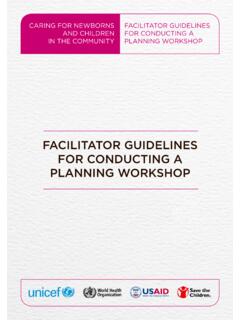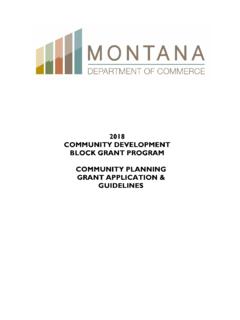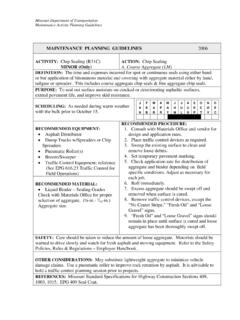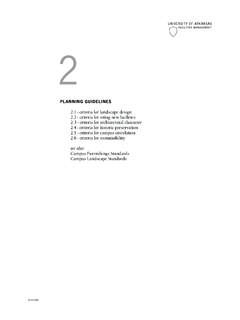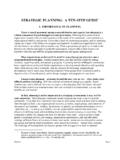Transcription of MARYLAND STATE FAMILY PLANNING PROGRAM CLINICAL …
1 MARYLAND STATE FAMILY PLANNING PROGRAM CLINICAL guidelines CENTER FOR MATERNAL AND CHILD HEALTH FAMILY HEALTH ADMINISTRATION MARYLAND DEPARTMENT OF HEALTH AND MENTAL HYGIENE MARYLAND STATE FAMILY PLANNING PROGRAM CLINICAL guidelines 2005 The 2005 edition of the MARYLAND STATE FAMILY PLANNING PROGRAM CLINICAL guidelines has been prepared by the staff of the Center for Maternal and Child Health and supersedes all previous CLINICAL guidelines and memoranda issued by this Office. These guidelines are primarily intended for use by clinic nurses, nurse clinicians, and physicians who care for FAMILY PLANNING and reproductive health clients.
2 These guidelines reflect the current medical opinions of leaders in the field of obstetrics and gynecology as well as related specialty boards. Please note that the methods of CLINICAL practice described are not intended to exclude other acceptable methods and may be modified in accordance with the CLINICAL situation and the clinician s experience. These guidelines are not intended to be a comprehensive discussion of all CLINICAL situations. Therefore, clinic nurses, nurse clinicians, and physicians rendering FAMILY PLANNING and reproductive health care are encouraged to consult with appropriate specialists whenever questions arise regarding CLINICAL management or treatment modalities.
3 Please note the inclusion of new topics and previous topics that have undergone major revisions. Future topics are being developed and will be forwarded as they are completed. The CLINICAL guidelines are to be utilized in conjunction with the MARYLAND STATE FAMILY PLANNING PROGRAM Administrative guidelines and should be kept in every clinic site in a clearly labeled loose-leaf binder. All staff who work in FAMILY PLANNING clinics should be familiar with the contents of both volumes. Each staff member should sign and date the guidelines after reviewing them.
4 The sign-off procedure by all FAMILY PLANNING staff is a quality assurance activity and should be recorded in the clinic quality assurance notebook. DHMH/FHA/CMCH MARYLAND STATE FAMILY PLANNING PROGRAM CLINICAL guidelines TABLE OF CONTENTS 07/25/08 Page 1 of 2 TABLE OF CONTENTS COMPONENTS OF ROUTINE FAMILY PLANNING COUNSELING ADOLESCENTS FAMILY AND INTIMATE PARTNER VIOLENCE MANDATED REPORTING OF CHILD ABUSE AND NEGLECT ( CLINICAL topics listed alphabetically) ABSTINENCE AMENORRHEA ANEMIA BACTERIAL VAGINOSIS BREAST DISEASE CERVICAL CANCER SCREENING CERVICAL NEOPLASIA MANAGEMENT CHANCROID CHLAMYDIA COITUS INTERRUPTUS COLPOSCOPY CONDOM - FEMALE CONDOM MALE CONDYLOMATA ACUMINATA CONTRACEPTION AFTER AGE 35 CONTRACEPTIVE EFFICACY DEPOT MEDROXYPROGESTERONE ACETATE (DMPA)
5 DIAPHRAGM DYSLIPIDEMIA DYSMENORRHEA ECTOPIC PREGNANCY EMERGENCY CONTRACEPTION PLAN B FERTILITY AWARENESS METHODS GLUCOSE SCREENING AND DIABETES MELLITUS GONORRHEA HEMOGLOBINOPATHY HEPATITIS B HEPATITIS C HERPES GENITALIS HUMAN IMUNNODEFICIENCY VIRUS (AIDS/HIV TESTING) HYPERTENSION IMPLANON SUBDERMAL CONTRACEPTIVE IMPLANT INFERTILITY INTRAUTERINE DEVICE - PARAGARD LACTATIONAL AMENORRHEA METHOD (LAM) LYMPHOGRANULOMA VENEREUM MOLLUSCUM CONTAGIOSUM NORPLANT NUVARING - VAGINAL CONTRACEPTIVE RING DHMH/FHA/CMCH MARYLAND STATE FAMILY PLANNING PROGRAM CLINICAL guidelines TABLE OF CONTENTS 07/25/08 Page 2 of 2 ORAL CONTRACEPTION ORTHO EVRA - CONTRACEPTIVE PATCH PEDICULOSIS PUBIS POSTPARTUM EVALUATION AND CONTRACEPTION PRECONCEPTION COUNSELING PREGNANCY TESTING PREMENSTRUAL SYNDROME RUBELLA SCABIES SPERMICIDES STANDARD DAYS METHOD STERILIZATION FEMALE STERILIZATION MALE SUBSTANCE ABUSE SYPHILIS TRICHOMONIASIS TUBERCULOSIS URINARY TRACT INFECTION VULVOVAGINAL
6 CANDIDIASIS ( FAMILY PLANNING consents) CONSENT FOR COLPOSCOPIC EXAMINATION CONSENT FOR CRYOTHERAPY CONSENT FOR DEPOT MEDROXYPROGESTERONE ACETATE (DMPA) CONSENT FOR FAMILY PLANNING SERVICES CONSENT FOR IMPLANON SUBDERMAL CONTRACEPTIVE IMPLANT CONSENT FOR INTRAUTERINE DEVICE PARAGARD CONSENT FOR NORPLANT REMOVAL CONSENT FOR NUVARING VAGINAL CONTRACEPTIVE RING CONSENT FOR ORAL CONTRACEPTIVES (BIRTH CONTROL PILLS) CONSENT FOR ORTHO EVRA CONTRACEPTIVE PATCH CONSENT FOR PLAN B EMERGENCY CONTRACEPTIVE PILLS FAMILY PLANNING INDIVIDUALIZED CONTACT PLAN ( FAMILY PLANNING encounter forms)
7 CHRONOLOGIC COLPOSCOPY FLOW RECORD FAMILY PLANNING COLPSCOPY RECORD FAMILY PLANNING FLOW RECORD FAMILY PLANNING IMPLANON INSERTION RECORD FAMILY PLANNING IMPLANON REMOVAL RECORD FAMILY PLANNING INITIAL RECORD FAMILY PLANNING INTERVAL RECORD FAMILY PLANNING IUD INSERTION RECORD FAMILY PLANNING ORAL CONTRACEPTIVE INITIATION RECORD FAMILY PLANNING PLAN B EMERGENCY CONTRACEPTION RECORD PREGNANCY TESTING ENCOUNTER RECORD COMPONENTS OF ROUTINE FAMILY PLANNING History Reason for visit Age Allergies Current medications/vitamins/herbs Current method of contraception Previous method of contraception Current primary care clinician Sexual History Age of onset Number of partners in lifetime Number of new partners Number of current partners Partner history Gender of partners Types of sex acts High-risk behavior Date of last vaginal intercourse Obstetric History Gravidity Parity Abortions (spontaneous or elective) Preterm births Living children Delivery type(s) Complications Date of last delivery (or date of last pregnancy termination)
8 Breastfeeding Gynecologic History Last menstrual period Menarche Length of cycle Length of flow Reproductive tract infection history, including abnormal Pap, HPV, HSV, gonorrhea, chlamydia, syphilis, bacterial vaginosis Surgery Current or Past Medical History Medical problems Asthma Headaches Cardiovascular disease DHMH/FHA/CMCH MARYLAND STATE FAMILY PLANNING PROGRAM CLINICAL guidelines COMPONENTS OF FAMILY PLANNING 6/7/05 Page 1 of 3 Liver disease Kidney disease GI disease Diabetes mellitus Thromboembolic disease Coagulopathies Mental health disorders Infectious Disease History Sexually transmitted diseases Hepatitis HIV Social History Alcohol Smoking Drug use Domestic violence Sexual abuse/assault Child abuse FAMILY
9 History Heart disease Diabetes Addictions Cancer (ovary, breast, uterus) Physical Examination Blood pressure Weight Height Thyroid Heart Lungs Breasts Abdomen Extremities Pelvis Skin Laboratory Testing Hgb/Hct Rubella screen Hepatitis B screen HIV STS Urine dipstick Pap DHMH/FHA/CMCH MARYLAND STATE FAMILY PLANNING PROGRAM CLINICAL guidelines COMPONENTS OF FAMILY PLANNING 6/7/05 Page 2 of 3 GC Chlamydia HPV Urine pregnancy test Counseling Abstinence Postponing sexual involvement Preventing unintended pregnancy Contraceptive options Emergency contraception Preconception
10 Weight/diet/nutrition Vitamins Folic acid Calcium Exercise Sexually transmitted infections Partner selection Barrier protection Psychosocial Personal goals Behavior/learning disorder Abuse/neglect Interpersonal/peer/ FAMILY relationships FAMILY involvement Domestic violence Depression/suicide Lifestyle/stress Health/risk behaviors Breast self-evaluation Substance abuse (drugs, tobacco, alcohol) Excess ultraviolet light Tattoos/body piercing The frequency and extent of investigation of the individual components are dependent on the type and frequency of each FAMILY PLANNING visit, reason(s) for the visit, contraceptives in use and/or being considered for use, and findings from the physical examination and laboratory testing.










